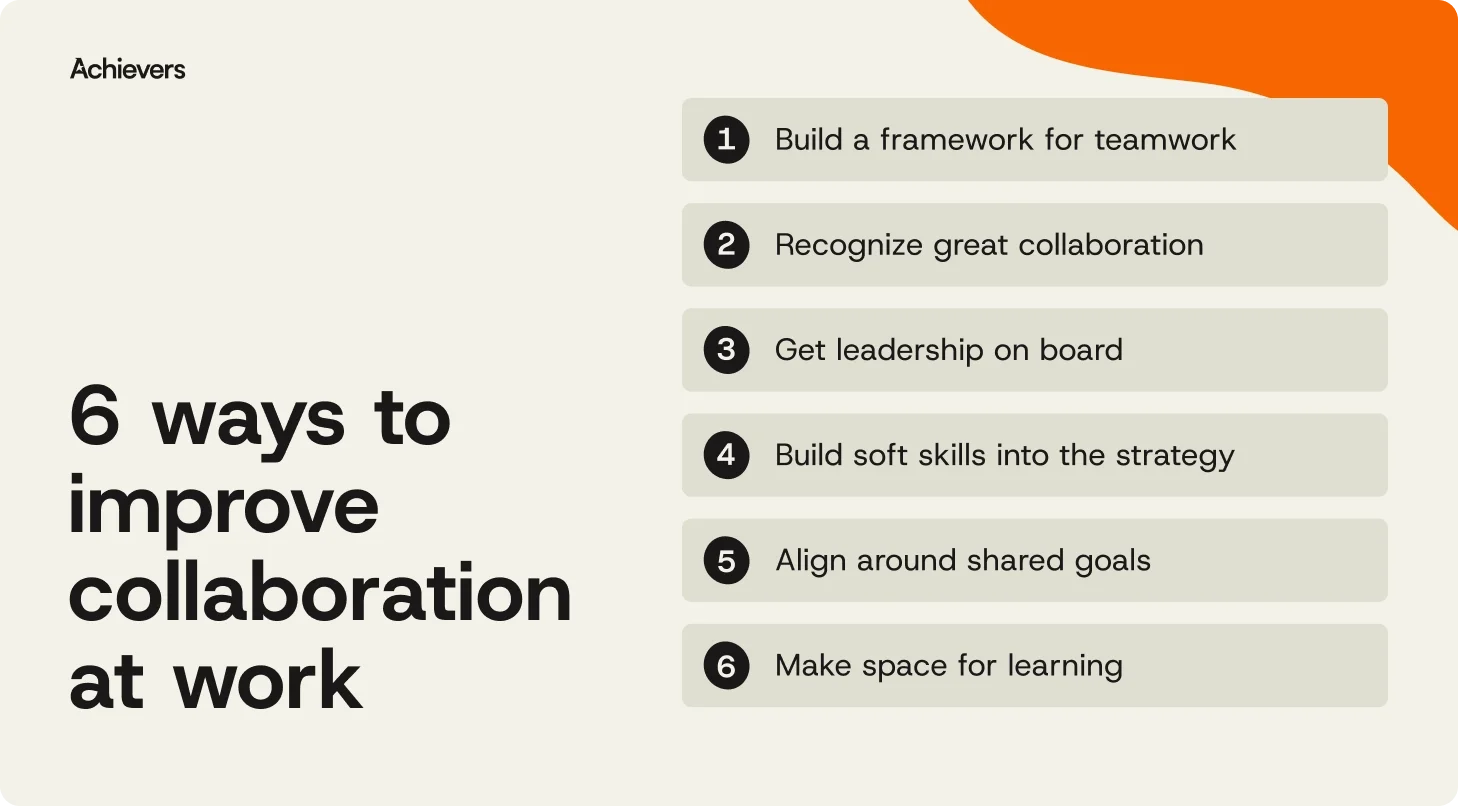Table of contents
Create a culture that means business™
Schedule a demo with an Achievers solution expert today.
Collaboration at work is meant to make life easier, not drain 25 billion hours a year.
And yet, that’s exactly what’s happening. A 2024 Atlassian study of Fortune 500 companies found that poor collaboration is costing teams time, focus, and a whole lot of patience. Scattered tools, unclear ownership, and misaligned goals are getting in the way of progress and people.
The good news? It’s fixable. Strong collaboration doesn’t require more meetings — just better ones. And with the right structure and support, teams can spend less time chasing clarity and more time doing work that actually matters. Let’s explore what great collaboration really looks like — and six practical ways to build it into the everyday.
6 ways to improve collaboration at work
So, how do you turn collaboration from a workplace ideal into something people actually experience day to day? Start here — with six strategies that help teams work better together.

1. Build a smarter framework for teamwork
Clear expectations and consistent tools set the stage for better collaboration, without the chaos.
- Pick the right channels for the job: Slack isn’t the place for policy updates, and a Zoom call doesn’t need to be your go-to for every brainstorm. Set clear guidelines around when to use chat, email, meetings, or project tools so messages land — and don’t get lost in the noise.
- Meet with intention: If the meeting could’ve been a memo, make it one. When meetings are necessary, come in with an agenda, a purpose, and an exit strategy. Structure signals respect for people’s time — and better outcomes, too.
- Clarify who owns what: Collaboration thrives on accountability. Spell out who’s responsible for timelines, goals, data, and decisions upfront. That way, no one’s left wondering, “Wait, was I supposed to do that?”
- Standardize your toolkit: Decide on the core platforms your teams will use — and stick to them. Tools should connect seamlessly across functions, not create more silos. Bonus points if they support software integrations, like Achievers does, so appreciation becomes part of everyday workflows.
- Encourage knowledge sharing across teams: Don’t let expertise stay siloed. Create space for teams to share processes, learnings, and tools — whether through cross-functional check-ins, shared resources, or quick “what worked” write-ups.
2. Recognize great collaboration — loudly and often
When you shine a light on teamwork, people are more likely to lean in.
- Call out cross-functional wins: Collaboration often happens behind the scenes. Surface it. Publicly shout out teams that work well together — whether in meetings, company-wide emails, or that Slack channel people actually read.
- Loop in leadership: Let managers know when their people are showing up for each other. Recognition travels further when it comes from the top, especially when it’s tied to business outcomes or company values.
- Make it easy to say “thank you”: Give employees tools to recognize each other in the moment. A social, points-based platform (like, say, Achievers) turns appreciation into a habit, not a once-a-quarter performance review shoutout. And it matters: 42% of employees who receive frequent peer recognition are very engaged at work, according to the State of Recognition Report.
3. Get leadership on board (and visible)
Collaboration starts at the top, and leaders need to walk the talk.
- Model collaborative behavior: Leaders who share credit, listen first, and pitch in where needed create space for others to do the same. It’s not just about setting expectations — it’s about setting the tone.
- Invest in training that sticks: Help leaders understand why collaboration matters — not just for culture, but for outcomes. Offer practical guidance on how to foster it across their teams, from role clarity to cross-functional alignment.
- Turn alignment into action: Encourage leaders to connect big-picture goals with everyday projects. When people see how their work supports something larger, they’re more likely to pull together — and more likely to recognize that effort in others.
4. Build soft skills into the strategy
Good collaboration isn’t just technical — it’s personal.
- Train the “people” part of work: Communication, empathy, adaptability — they’re the unsung heroes of collaboration. Make soft skills part of your talent development efforts, not an afterthought.
- Start with your early-career talent: Younger employees may have less experience navigating team dynamics. Pair them with mentors who model healthy collaboration habits and can help build their confidence.
- Don’t just teach — demonstrate: Culture is contagious. Encourage managers and senior team members to model the behaviors you want others to adopt, and use recognition to reinforce those moments as they happen.
- Invite different perspectives: Great collaboration benefits from variety in backgrounds, thinking styles, and lived experiences. Encourage input from across the company, especially when teams are solving tough or high-impact challenges.
5. Align around shared goals — not just shared calendars
Teams need more than a meeting invite to feel connected to a common purpose.
- Set department-level goals that support the bigger picture: Company-wide OKRs are a start, but bring things down to earth. Help teams map how their work connects to broader outcomes, and you’ll build alignment without forcing buy-in.
- Make goals visible and trackable: Use dashboards, team check-ins, or your recognition platform to showcase progress and reinforce collaborative wins. Visibility boosts motivation — and helps teams feel like they’re in it together.
- Celebrate progress — not just perfection: Hitting the final milestone is great, but don’t wait until then to recognize the teamwork it took to get there. Platforms like Achievers let you spotlight these moments quickly, so recognition doesn’t get buried under next-quarter goals.
6. Make space for learning together
Collaboration is a fast track for development, if you let it be.
- Encourage skill-sharing: Pair team members with different strengths on projects to build new capabilities through experience, not just training.
- Welcome diverse perspectives: Bring in different roles, backgrounds, and approaches when solving complex problems. Innovation thrives on contrast.
- Debrief and learn from outcomes: After key projects, carve out time to reflect as a team — what worked, what didn’t, and what can be carried forward.
The benefits of collaboration at work
When collaboration clicks, your whole workplace feels the difference. Here’s how:
- Better communication: Collaboration creates clarity. When teams work together often — and intentionally — strong communication becomes a byproduct, not a battle.
- Improved knowledge sharing: Ideas move faster when silos break down. Cross-functional collaboration opens the door to fresh perspectives, creative solutions, and fewer “oh, I didn’t know that was happening” moments.
- Increased productivity: When people know who to loop in, what tools to use, and how to get things done together, they waste less time chasing clarity and more time hitting goals.
- A stronger sense of belonging: Teams that collaborate well build real relationships. That means more trust, more empathy, and a deeper connection to the company culture and each other.
- More recognition-worthy moments: Good teamwork creates plenty of reasons to celebrate — and with Achievers, those moments don’t go unnoticed. Organizations that use Achievers to build a culture of recognition are 3X more likely to see increased employee engagement and retention.
The challenges of workplace collaboration
Collaboration doesn’t always come naturally. Here’s what can get in the way — and what to do about it.
- Trust takes time: Not everyone is quick to lean on their teammates, especially if they’ve dealt with broken systems or bad culture before. To rebuild trust, lead with it. Set clear expectations, follow through, and create space for people to rely on each other.
- Let people own their work: Micromanaging does more harm than good. Empower teams to make decisions, check in regularly, and then step back. Trust builds faster when managers act like coaches, not drill sergeants.
- Use feedback to make real changes: When employees speak up, they’re hoping to see change, not just a polite nod. Collect input regularly and use it to improve processes and clear roadblocks. A platform like Achievers makes it easy to close the loop by turning feedback for managers into real action.
- Give people room to grow: Stretch assignments are a great way to build confidence and connection. When leaders hand over meaningful projects — and recognize that effort — it shows trust and opens the door to stronger collaboration.
- Some people need help speaking up: Not everyone finds it easy to speak their mind, especially with leadership in the room. Create space for honest conversations by encouraging open dialogue and practicing active listening. Clear communication is a skill, not a given.
- Too many tools, not enough alignment: If your teams are working in different systems, things fall through the cracks. Choose a core set of tools that actually support how people work, including ones that bring recognition, communication, and feedback into one place. (Don’t worry, Achievers can help with that.)
Collaboration doesn’t just happen. It’s built — and recognized
The truth is, even the best teams need structure, support, and a little acknowledgment now and then. When collaboration is nurtured, recognized, and made visible, it becomes part of how your company operates, not just how it aspires to.
With Achievers, you don’t have to cross your fingers and hope it all clicks. You can build a culture where collaboration feels natural, feedback flows freely, and recognition fuels results.
Learn how recognition can drive connection, culture, and more, no matter what challenge you’re solving for.



